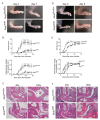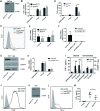Nardilysin is involved in autoimmune arthritis via the regulation of tumour necrosis factor alpha secretion
- PMID: 28955486
- PMCID: PMC5604610
- DOI: 10.1136/rmdopen-2017-000436
Nardilysin is involved in autoimmune arthritis via the regulation of tumour necrosis factor alpha secretion
Abstract
Objective: Tumour necrosis factor alpha (TNF-α) plays an important role in rheumatoid arthritis (RA). TNF-α is synthesised as a membrane-anchored precursor and is fully activated by a disintegrin and metalloproteinase 17 (ADAM17)-mediated ectodomain shedding. Nardilysin (NRDC) facilitates ectodomain shedding via activation of ADAM17. This study was undertaken to elucidate the role of NRDC in RA.
Methods: NRDC-deficient (Nrdc-/- ) mice and macrophage-specific NRDC-deficient (NrdcdelM ) mice were examined in murine RA models, collagen antibody-induced arthritis (CAIA) and K/BxN serum transfer arthritis (K/BxN STA). We evaluated the effect of gene deletion or silencing of Nrdc on ectodomain shedding of TNF-α in macrophages or monocytes. NRDC concentration in synovial fluid from patients with RA and osteoarthritis (OA) were measured. We also examined whether local gene silencing of Nrdc ameliorated CAIA.
Results: CAIA and K/BxN STA were significantly attenuated in Nrdc-/- mice and NrdcdelM mice. Gene deletion or silencing of Nrdc in macrophages or THP-1 cells resulted in the reduction of TNF-α shedding. The level of NRDC is higher in synovial fluid from RA patients compared with that from OA patients. Intra-articular injection of anti-Nrdcsmall interfering RNA ameliorated CAIA.
Conclusion: These data indicate that NRDC plays crucial roles in the pathogenesis of autoimmune arthritis and could be a new therapeutic target for RA treatment.
Keywords: Autoantibodies; Rheumatoid arthritis; Synovial fluid; TNF-alpha.
Conflict of interest statement
Competing interests: None declared.
Figures





Similar articles
-
Ectodomain shedding of TNF-alpha is enhanced by nardilysin via activation of ADAM proteases.Biochem Biophys Res Commun. 2008 May 23;370(1):154-8. doi: 10.1016/j.bbrc.2008.03.050. Epub 2008 Mar 18. Biochem Biophys Res Commun. 2008. PMID: 18355445
-
Nardilysin and ADAM proteases promote gastric cancer cell growth by activating intrinsic cytokine signalling via enhanced ectodomain shedding of TNF-α.EMBO Mol Med. 2012 May;4(5):396-411. doi: 10.1002/emmm.201200216. Epub 2012 Feb 20. EMBO Mol Med. 2012. PMID: 22351606 Free PMC article.
-
Amelioration of Experimental Autoimmune Arthritis Through Targeting of Synovial Fibroblasts by Intraarticular Delivery of MicroRNAs 140-3p and 140-5p.Arthritis Rheumatol. 2016 Feb;68(2):370-81. doi: 10.1002/art.39446. Arthritis Rheumatol. 2016. PMID: 26473405
-
K/BxN Serum-Transfer Arthritis as a Model for Human Inflammatory Arthritis.Front Immunol. 2016 Jun 2;7:213. doi: 10.3389/fimmu.2016.00213. eCollection 2016. Front Immunol. 2016. PMID: 27313578 Free PMC article. Review.
-
Arthritic and non-arthritic synovial fluids modulate IL10 and IL1RA gene expression in differentially activated primary human monocytes.Osteoarthritis Cartilage. 2015 Nov;23(11):1853-7. doi: 10.1016/j.joca.2015.06.003. Osteoarthritis Cartilage. 2015. PMID: 26521731 Review.
Cited by
-
Auxiliary roles of nardilysin in the early diagnosis of acute coronary syndrome: a prospective cohort study, the Nardi-ACS study.Intern Emerg Med. 2024 Apr;19(3):649-659. doi: 10.1007/s11739-023-03508-0. Epub 2024 Jan 17. Intern Emerg Med. 2024. PMID: 38233578 Free PMC article.
-
MEF2C regulates osteoclastogenesis and pathologic bone resorption via c-FOS.Bone Res. 2021 Jan 11;9(1):4. doi: 10.1038/s41413-020-00120-2. Bone Res. 2021. PMID: 33424022 Free PMC article.
References
LinkOut - more resources
Full Text Sources
Other Literature Sources
Miscellaneous
